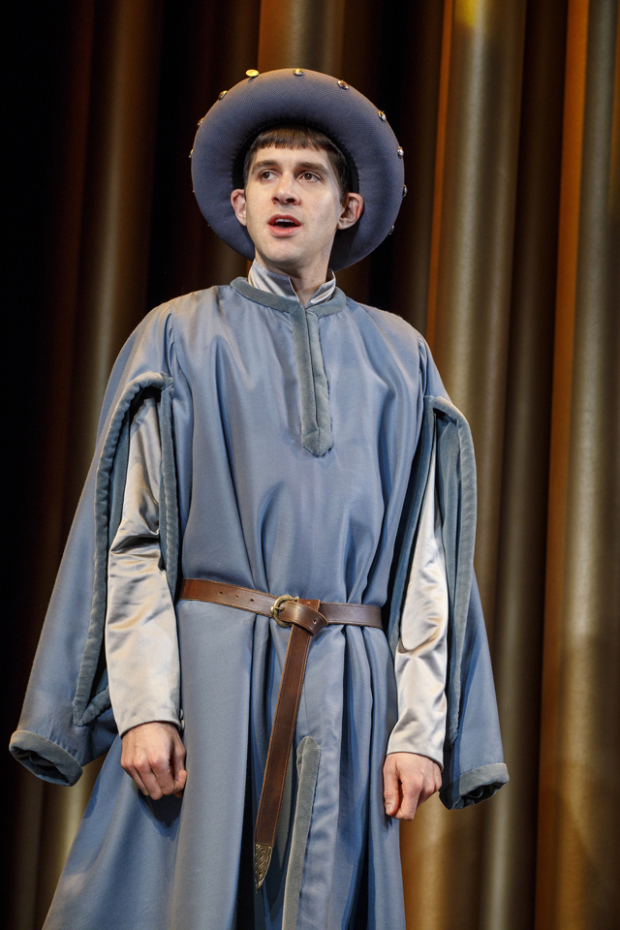Final Bow: Adam Chanler-Berat Prepares to Step Down From His Throne in Saint Joan
Chanler-Berat conjures a 15th-century monarch and the full potential of his hair for Manhattan Theatre Club’s revival of Bernard Shaw’s iconic history play.
At the beginning of Saint Joan, the Dauphin (later King Charles VII of France) has been disinherited by his father and left with almost no territory over which to rule. Enter Joan of Arc, the teenage soldier and spiritual leader who helps disperse British troops and eventually coronate Charles VII, making him a true king.
Adam Chanler-Berat plays this feckless monarch who gains a little bit of courage from Joan (Condola Rashad) and her divine inspiration in the latest revival of Bernard Shaw's Saint Joan, running through June 10 at the Samuel J. Friedman Theatre. Known for his roles in Next to Normal, Peter and the Starcatcher, and his last Broadway turn in the musical adaptation of Amélie, Chanler-Berat is very familiar with bringing new work to the stage. But as his first-ever Broadway revival draws to a close, let's see how he enjoyed ruling a Broadway stage in an almost-century-old masterpiece.

(© Joan Marcus)
1. What is your favorite line that you get to say?
It's always changing, but today, "Yes it is always you good men that do the big mischiefs."
2. Everyone loves inside jokes. What is the best one from your show?
Condola has a line in our scene at the top of Act 2, where I propose a treaty with the English, something she vehemently opposes. She says, "Treaty?" And in tech we were goofing around and she made it really contemporary, playing the scene like we were a group of high schoolers. Every now and then, little glimpses of that version pop up in performance. I don't think anyone would notice, but it brings us joy.
3. Every show experiences technical difficulties. What was the worst technical difficulty experienced during your show and how was it handled?
Things go awry constantly. It's live theater. Projections don't work and leave us in the dark, water gets spilled onstage leaving us tiptoeing around. Most recently, an actor entered early in a scene, and we had to find our way back and make sure we covered all the necessary information. It made the scene feel so alive.
4. What was the most "interesting" present someone gave you at the stage door?
I had a love at the stage door, Zoe, who made a little figurine version of me. It was the Broadway version of an action figure. Teenage Adam wouldn't believe it.
5. Who is the coolest person that came to see your show? (You can't say your family!)
Playwright and book writer John Weidman and actor Michael McKean.

(© Joan Marcus)
6. Why do you think Shaw decided to write Charles VII as dopey rather than kingly?
I don't think of him as a dope. Maybe that's how he appears, which is fine. I think Shaw looked at history. And history tells us that Charles was the youngest in a long line to inherit the throne and that he felt very paranoid about the dangers that come with power, but eventually became Charles the Victorious. Being a lover of irony, I think this contradiction may have really appealed to Shaw. And as an actor it makes for an interesting and complicated character to play.
7. How does your Dauphin wig make you feel?
It is my great pleasure to tell you that that the Dauphin wig is in fact my real hair, combed forward.
8. Saint Joan has some heavy drama but there's also plenty of comic relief. What moment in the play makes you laugh?
Robert Stanton, a tremendous actor in our company, plays a tightly wound, by-the-book, English Chaplain. And he always tickles my funny bone.
9. This is the first Broadway revival you've done. How has it compared to bringing new work to the Broadway stage?
The main difference is that the ground isn't shifting under you. We made some trims here and there, but this text has essentially been the same since day one. In new musicals, you can come in and have several new scenes daily. And to integrate them flexes a different kind of muscle. But also, new work is being tailored to you. It's written with you in mind. And in some ways, you have less of a distance to meet it.
10. The play ends 25 years after Joan's execution and your character is visited by some ghosts from his past. Who do you want haunting your bedroom 25 years from now?
Mr. Rogers.







